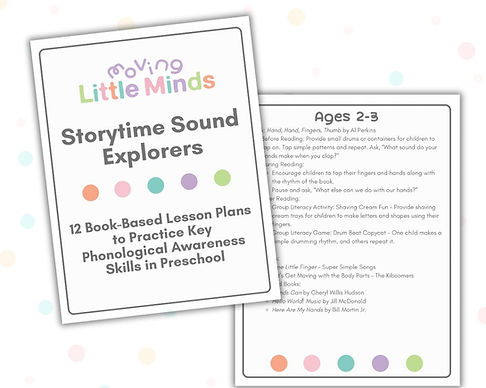Rethinking What Family Partnership Truly in Preschool...and the IMPACT It Can Make!
- Melissa McCall
- 1 day ago
- 6 min read

The Truth that STUNG...
How many times have you said the phrase, “parents as partners," and then five minutes later turn around and complain about those very same parents? Ummm...Guilty!
That was exactly how I felt sitting in a training session at the Zero to Three Conference. I was thrilled to hear one of my favorite NAEYC leaders speak about developmentally appropriate play, but what I didn’t expect was how clearly she emphasized one vital truth: families are part of the child. They are part of developmentally appropriate play, and as Alissa Mwenelupembe of NAEYC said, "You have to see the families as partners, no matter how they show up." Later, during the keynote, Dr. Brown drove it home with a quote that’s been echoing in my mind ever since, “The whole child includes the family.”
This theme of family partnership kept surfacing again and again, at both conferences I attended and in so many recent conversations with directors. It’s clear that family involvement isn’t just an ongoing challenge; it’s one of the greatest opportunities we have to make a lasting impact when we’re willing to look a little deeper.
Did you know...Students whose parents stay involved in school tend to have better attendance, stronger behavior, higher grades, and greater social skills, and they adapt more easily to new school environments (The Annie E. Casey Foundation, 2022). Research continues to show that family partnership isn’t just “nice to have”, but one of the most powerful predictors of long-term academic success.
In fact, a longitudinal study of over 1,500 families found that early parent involvement directly influenced kindergarten achievement, and that connection continued to shape motivation and success in later grades (Hayakawa et al., 2013).
As we move into November, a month centered on gratitude and kindness, it feels like the perfect time to lean into this conversation about strengthening family involvement in meaningful ways.
True kindness in education is about understanding families so we can best help children grow. Preschool teachers can’t do this work alone, and parents genuinely want to help. Sometimes, they just don’t know how.
Rethinking Family Partnership

When we think about family partnership, it’s easy to fall into the familiar patterns: invite families in for a special event, send home the weekly newsletter, or demonstrate an activity they can try at home. Those things matter...they build visibility and connection.
But if we stop there, we’re missing a bigger opportunity.
Just as we get to know the children in our classrooms, we need to get to know the families who raise them. I’ve shared tools in my newsletters before, such as my Child-Led Student Surveys to send to families so that we can help teachers understand children’s interests and behaviors, but what about asking the caregivers themselves?
Are we asking questions like:
What are you interested in learning more about?
How do you prefer to communicate: text, email, phone call, in person?
How do you approach behavior or routines at home?
What are your hopes for your child?
What are your expectations for your child right now?
When we ask those kinds of questions, we open doors. We better understand our families build trust along the way.
So how do we start shifting from family involvement to family partnership? Let's explore some ideas!
1. Foster Culturally Responsive Connections
Family engagement starts with understanding. Every family brings its own traditions, values, languages, and experiences. Those differences shape how they view learning and school. Taking time to learn about those cultural influences helps us move beyond assumptions and into true partnership.
This might look like:
Asking families about the traditions or routines they value most at home.
Learning key phrases in a family’s home language to use during greetings or conferences.
Reflecting on how your classroom environment and materials represent the cultures of your children.
When we approach families with curiosity instead of judgment, we create space for trust. Culturally responsive relationships remind families that they are seen, heard, and valued, not as “participants,” but as partners in their child’s growth.
Download the handout with our 10 favorite ways to provide culturally responsive literacy instruction!

2.Build True Relationships
Family partnership doesn’t grow just from event calendars or newsletters; it grows from connection. The most impactful relationships come from moments of genuine communication, shared goals, and mutual trust.
One of my favorite examples came from a preschool that added a small digital question at check-out:
“How are you doing today?” Parents could tap a quick rating from 1–5 before signing out their child.
If a parent marked a low score, a teacher or director would check in later that day or send a quick supportive note. It’s such a simple system, but it sends a powerful message: we care about you, not just your child.
Here are a few more ways schools can build that same kind of connection:
Create a “Family Wins” board or wall. Invite families to share something good happening at home, big or small. It’s a joyful way to build community and celebrate families beyond the classroom.
Send short, positive check-ins. A quick text or note that says, “Your child was so proud of their art project today!” can mean everything to a busy parent.
Include a “family focus” question in your newsletters. Instead of only sharing reminders, add a reflective question like, “What’s something new your child has learned to do at home this week?”
Host informal “Coffee and Conversation” mornings. No agenda, just a few minutes for parents to chat with teachers and each other while dropping off.
See some other great ideas shared by our teacher community HERE! Feel free to add in your idea!

When schools invest in relationships, families start to view educators not as service providers, but as allies. And when families feel supported, they are far more likely to engage, share insights, and partner in meaningful ways.
3. Practice Self-Awareness and Empathy
Before we can build stronger partnerships, we must first look inward. Every educator brings personal experiences, beliefs, and biases that influence how we interpret family interactions. Reflecting on those internal filters helps us approach families with empathy and openness.
Ask yourself:
What assumptions might I be making about this family’s priorities or challenges?
How do my own upbringing and values influence the way I view “involvement”?
Can I put myself in their shoes?
Am I listening to understand or listening to respond?
When we shift our mindset, we begin to see families differently. We stop labeling them as “uninvolved” or “hard to reach” and start recognizing the unique ways they show care. Why aren't they responding? Find this out FIRST...you will probably be surprised, and may even be able to offer support or a change in your delivery.
My favorite reminder for this work: “Assume positive intent.” When we believe that families want the best for their children (and they do!) it changes the tone of every conversation and builds the foundation for true collaboration.
Final Thoughts...

Building authentic family partnerships starts with how we see and support families every day. It’s about truly getting to know not just the child, but the families as well. Because as Doc Brown put it, "The whole child includes the family," and therefore we can't effectively teach a child without understanding the family as well.
And research backs this up: children whose parents are actively involved show stronger literacy skills, greater motivation, and lasting academic benefits. Every connection you build today lays the groundwork for that success.
So this month, as we focus on gratitude and kindness, let’s remember: true kindness is connection, and every partnership with a family is a step toward changing a child’s story.
New to the Science of Reading? Join Our Free 3-Part Webinar Series

The Science of Reading Foundations: A 3-Part Mini-Series for Preschool Leaders is designed to give both directors and teachers the clarity, confidence, and practical tools to strengthen early literacy instruction. Ideal for anyone who wants clarity on what the Science of Reading really is, and how it shapes children’s futures.
Over three short, powerful sessions, we’ll take you on a journey from the why to the how:
Part 1: Understanding the Science of Reading: Finally get a clear, director-friendly explanation of what the Science of Reading really means, and why preschool is where it all begins.
Part 2: Phonological Awareness — The Gateway Skill: Learn exactly WHY phonological awareness skills are essential for our little learners and how and how teachers can embed them seamlessly into the day.
Part 3: Alphabet Knowledge — From Sounds to Symbols: Learn why it is time to let go of “letter of the week” and discover what science shows about how children learn the alphabet.
Whether you’re a preschool leader guiding your staff or a teacher looking for classroom-ready ideas, this series will help you gain a better understanding of how children learn to read and what we can do from an early age!
Happy Learning! Be sure to LIKE, SHARE and COMMENT on this post!
Don't miss an update from Moving Little Minds! SUBSCRIBE HERE!

We believe that every child deserves a bright future, and this begins with a strong foundation in early literacy skills. At Moving Little Minds, we are dedicated to providing research-based literacy activities in fun and engaging ways! By merging instruction with play, we ensure that children are reaching their full potential and embark on their educational journey well-prepared for the
future! Let's build those KEY emergent literacy skills together.






















%20(52).jpg)

Comments